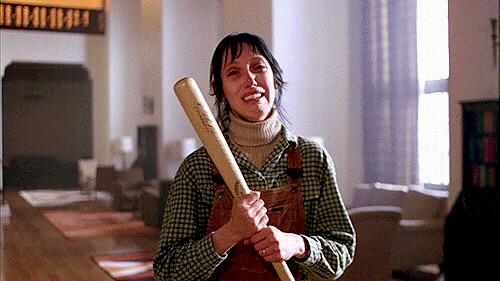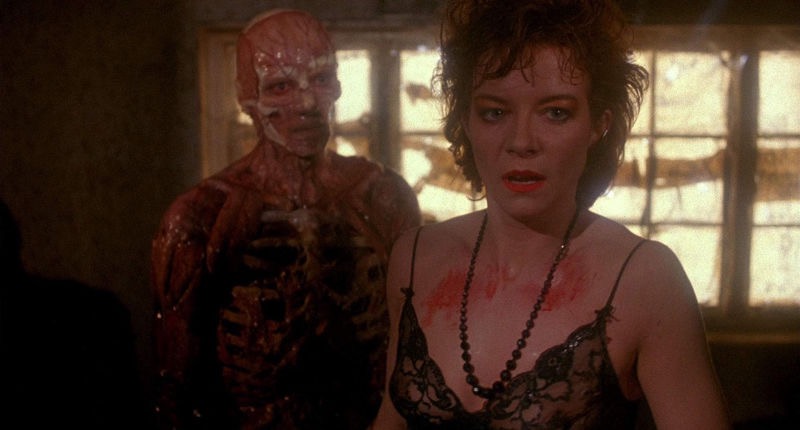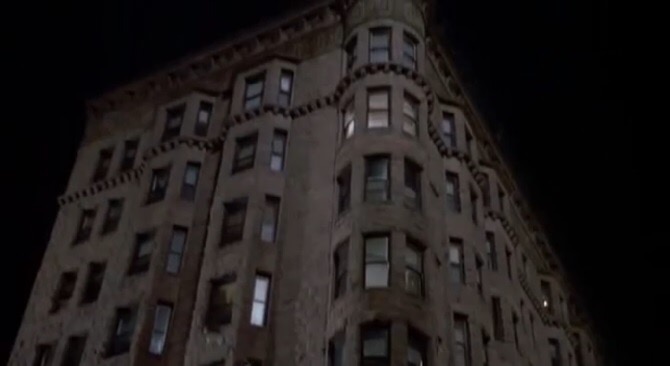
I had the amazing good fortune recently to see on the big screen one of my favorite movies of all time, The Shining, and it was simply incredible. However, it’s come to my attention lately, that a surprising number of people haven’t seen the movie, which to me is mind boggling. I always considered The Shining to be one of the smartest and most classic of horror movies, reliant on psychological terror rather than gore. I also am a tremendous film nerd and watched the film theory documentary Room 237, devoted exclusively to film interpretations of The Shining, and I’ll be talking about both in this review.
If you ever have the opportunity to see this film in theaters, do so immediately! I’ve seen this movie at least a dozen times by now, but it was a completely different movie on the big screen. I entered the theater right as the film opened, with the booming, ominous Dies Irae requiem playing as we follow Jack Torrance up the mountain towards his job interview at The Overlook hotel. I could probably spend an entire article talking about this opening sequence, but it almost makes you dizzy to see it in theater. The continuous shot, twists and turns along with the winding road leading up the Colorado mountains. This maze-like quality is repeated throughout the film in different forms and sets the viewer up for a movie that is full of fake-outs and confusion.

Although on its head this movie feels like a straightforward horror/thriller, but when the movie is on the big screen, there are inconsistencies and unshakeable images that stick with you long after you’ve left the theater. These are the sorts of things that the five film theorists of Room 237 spend the documentary discussing. Though the hotel is explored onscreen at great length (especially by Dany’s exploration via trike), there are things about the layout that do not make sense and register with the viewer subconsciously. Theorist Juli Kearns talks about the window in the room of the office in which Jack interviews, as an overly bright window and a powerful force in the room. It draws your eye in and is noticeable because it is, in fact, an impossible window—the location of the office seems to be somewhere near the center of the hotel, so how is there a window in the office?

John Fell Ryan, one of the other film theorists featured in Room 237, talks more about the inconsistencies, citing the moment Jack is waiting in the lobby of the hotel, reading a Playgirl magazine— an extremely inappropriate and unlikely choice of reading material given the setting. Theorist Jay Weidner speaks of a moment early in the film when Danny’s bathroom door can be seen plastered with stickers. One prominent sticker is Dopey, one of the seven dwarves from Snow White. It is after the audience sees this sticker that Danny receives his first vision of the Overlook hotel (featuring the iconic blood pouring out of the elevators), and afterwards, the Dopey sticker on the door is gone. Danny’s had his first taste of reality, and he’s not a dope anymore. These are small details, easily missed in a first or even second viewing, because Stanley Kubrick wanted that information to be absorbed subliminally, to generate a vague sense of unease, and that things are not right.
For me, the subtext of this film is about the abusive family relationship on display. From the very beginning of the film, a bottle of Joy dish soap is on display is the background, right next to Wendy’s head. Kubrick’s placement of this seemingly innocuous background prop is pure irony, because the Torrance family is completely joyless. It’s telling that at the film’s opening, the family separated—Jack is driving to his interview at The Overlook hotel, and Wendy and Danny are back home in Boulder. This is not a happy and healthy family unit, they’re fractured before the story even begins. Furthermore we learn that while drinking, Jack broke Danny’s collarbone, leading to Jack’s supposed promise to never drink again. However we subsequently learn that this is false, as Jack laments his five months on the wagon to his ghost bartender. The language Jack uses to discuss his wife is deplorable—he calls her a “sperm bank” and blames her for all his troubles, demonstrating a lack of regard for his family, juxtaposed with the reverence he has for The Overlook and his position as caretaker.

In his role of caretaker, however, Jack does very little to look after the hotel. As Juli Kearns notes, it is Wendy who we see doing most of the work around The Overlook. Wendy is a much stronger character than she seems at first, and even the spirits of the hotel admit that they underestimated her resilience. While she first comes off as a meek and subservient wife, we see her question Dick Hallorann when he uses her son’s nickname, and even presses the issue because she knows that he didn’t overhear her using it since they’ve been to the hotel. This woman is much sharper than everyone around her gives her credit for. At the same time, this is a woman who knows what shape her family is in. She knows her husband’s history and abusive nature that hides below the surface, and she rightfully suspects him when her son is injured at the hotel. She also knows enough to take a baseball bat with her when she goes to confront her husband about leaving the hotel. This is clearly not a woman facing abuse for the first time.

Danny is similarly aware of the state of his family unit, and like Wendy, he knows more than anyone else gives him credit for. Danny sees blood and horror when he “shines” in on his parents arguing, because he knows their dynamic, and what will ultimately come of it. His imaginary friend Tony is really an advanced coping mechanism in the face of an unhealthy family. Tony is the one who shows him what The Overlook is really like, and Tony also takes over after Danny has been too traumatized by entering room 237 to function. Tony is the one who writes redrum on the door for Wendy, effectively waking her up, both literally and figuratively, to the danger they are in.
Upon this particular viewing, I stumbled across another angle of interpretation within the film. As I watched the story unfold, I came to the part of the movie when Wendy pushes Danny out the bathroom window to safety, and later Wendy is stuck in the maze of the hotel, while Danny and Jack are stuck in the actual maze outside. I came to realize just how unlikely it is that Danny and Wendy reunite at the end of the movie, with Wendy running out of the hotel just in time to meet Danny running out of the maze. In a hotel and surrounding grounds as large as The Overlook, how the hell did they manage to run into each other at just the right time to escape? The two climb into Hallorann’s abandoned snowmobile and ride to safety. But I noticed as they rode away, a sheet of fog passes by, obscuring their exit. Did they really escape this nightmare scenario? Maybe. But could they also not have made it out with their lives? Could it all be a dream, and perhaps Jack did kill his wife and son—did they disappear into the fog as ghosts?

Of course, there is no answer to these questions. Stanley Kubrick is dead, and even if he wasn’t, he would never give a definitive answer to these film conspiracy theories. Because that’s what film theory is—it’s all interpretation and guesses, with no distinct answer. John Fell Ryan speaks in Room 237 that movies are like quantum physics, in the way that the through act of observing, the thing is changed. Everyone who watches a movie, passes it through their own cipher of life experiences and overall knowledge. It’s why I can watch The Shining and see a movie about abusive families, and another can watch it and see a film that represents the plight of Native Americans (a surprisingly accurate and well-proven reading). Ultimately the film is a true ghost story, everyone sees what they see, and no two viewers see exactly the same thing, just as Kubrick intended.

Room 237 is a fantastically made documentary that particularly appeals to film nerds and horror movie geeks, or just anyone with a love for The Shining, and happens to be streaming right now on Netflix.



































